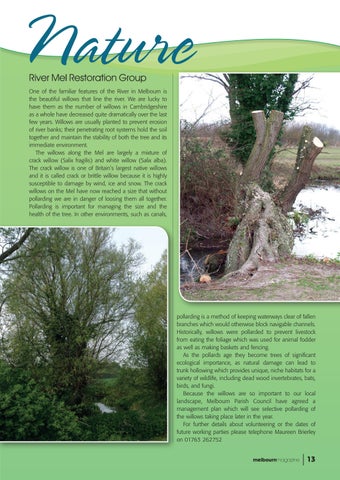Nature River Mel Restoration Group
One of the familiar features of the River in Melbourn is the beautiful willows that line the river. We are lucky to have them as the number of willows in Cambridgeshire as a whole have decreased quite dramatically over the last few years. Willows are usually planted to prevent erosion of river banks; their penetrating root systems hold the soil together and maintain the stability of both the tree and its immediate environment. The willows along the Mel are largely a mixture of crack willow (Salix fragilis) and white willow (Salix alba). The crack willow is one of Britain’s largest native willows and it is called crack or brittle willow because it is highly susceptible to damage by wind, ice and snow. The crack willows on the Mel have now reached a size that without pollarding we are in danger of loosing them all together. Pollarding is important for managing the size and the health of the tree. In other environments, such as canals,
pollarding is a method of keeping waterways clear of fallen branches which would otherwise block navigable channels. Historically, willows were pollarded to prevent livestock from eating the foliage which was used for animal fodder as well as making baskets and fencing. As the pollards age they become trees of significant ecological importance, as natural damage can lead to trunk hollowing which provides unique, niche habitats for a variety of wildlife, including dead wood invertebrates, bats, birds, and fungi. Because the willows are so important to our local landscape, Melbourn Parish Council have agreed a management plan which will see selective pollarding of the willows taking place later in the year. For further details about volunteering or the dates of future working parties please telephone Maureen Brierley on 01763 262752 melbournmagazine
13












